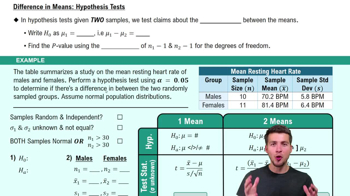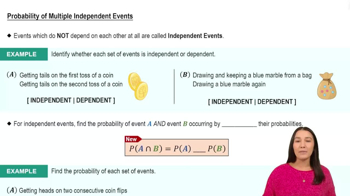Clancy, Rowling, and Tolstoy Ease of Reading Pages were randomly selected from three books: The Bear and the Dragon by Tom Clancy, Harry Potter and the Sorcerer’s Stone by J. K. Rowling, and War and Peace by Leo Tolstoy. Listed below are Flesch Reading Ease Scores for those pages. Higher scores correspond to pages that are easier to read. Use a 0.01 significance level to test the claim that pages from books by those three authors have the same median Flesch Reading Ease score.
Table of contents
- 1. Intro to Stats and Collecting Data1h 14m
- 2. Describing Data with Tables and Graphs1h 55m
- 3. Describing Data Numerically2h 5m
- 4. Probability2h 16m
- 5. Binomial Distribution & Discrete Random Variables3h 6m
- 6. Normal Distribution and Continuous Random Variables2h 11m
- 7. Sampling Distributions & Confidence Intervals: Mean3h 23m
- Sampling Distribution of the Sample Mean and Central Limit Theorem19m
- Distribution of Sample Mean - Excel23m
- Introduction to Confidence Intervals15m
- Confidence Intervals for Population Mean1h 18m
- Determining the Minimum Sample Size Required12m
- Finding Probabilities and T Critical Values - Excel28m
- Confidence Intervals for Population Means - Excel25m
- 8. Sampling Distributions & Confidence Intervals: Proportion1h 12m
- 9. Hypothesis Testing for One Sample3h 29m
- 10. Hypothesis Testing for Two Samples4h 50m
- Two Proportions1h 13m
- Two Proportions Hypothesis Test - Excel28m
- Two Means - Unknown, Unequal Variance1h 3m
- Two Means - Unknown Variances Hypothesis Test - Excel12m
- Two Means - Unknown, Equal Variance15m
- Two Means - Unknown, Equal Variances Hypothesis Test - Excel9m
- Two Means - Known Variance12m
- Two Means - Sigma Known Hypothesis Test - Excel21m
- Two Means - Matched Pairs (Dependent Samples)42m
- Matched Pairs Hypothesis Test - Excel12m
- 11. Correlation1h 6m
- 12. Regression1h 50m
- 13. Chi-Square Tests & Goodness of Fit1h 57m
- 14. ANOVA1h 57m
9. Hypothesis Testing for One Sample
Steps in Hypothesis Testing
Problem 12.CQ.5
Textbook Question
Cola Weights The displayed results from Exercise 1 are from one-way analysis of variance. What is it about this test that characterizes it as one-way analysis of variance instead of two-way analysis of variance?
 Verified step by step guidance
Verified step by step guidance1
Understand the concept of one-way analysis of variance (ANOVA): One-way ANOVA is used to compare the means of three or more independent groups based on one independent variable (factor). It tests whether there is a statistically significant difference between the group means.
Contrast this with two-way ANOVA: Two-way ANOVA involves two independent variables (factors) and examines the interaction between them, as well as their individual effects on the dependent variable.
Identify the key characteristic of the test in the problem: The test described in the problem involves only one independent variable (factor), which is why it is classified as one-way ANOVA.
Recognize the absence of interaction effects: In one-way ANOVA, there is no consideration of interaction effects between multiple factors, which is a defining feature of two-way ANOVA.
Conclude why this test is one-way ANOVA: Since the analysis focuses on a single factor affecting the dependent variable (cola weights), it is characterized as one-way ANOVA rather than two-way ANOVA.
 Verified video answer for a similar problem:
Verified video answer for a similar problem:This video solution was recommended by our tutors as helpful for the problem above
Video duration:
1mPlay a video:
Was this helpful?
Key Concepts
Here are the essential concepts you must grasp in order to answer the question correctly.
One-Way Analysis of Variance (ANOVA)
One-way ANOVA is a statistical method used to compare the means of three or more independent groups based on one independent variable. It tests the null hypothesis that all group means are equal, allowing researchers to determine if at least one group mean significantly differs from the others. This method is particularly useful when assessing the impact of a single factor on a dependent variable.
Recommended video:
Guided course

Difference in Means: Hypothesis Tests
Two-Way Analysis of Variance (ANOVA)
Two-way ANOVA extends the one-way ANOVA by examining the influence of two independent variables on a dependent variable. It not only assesses the main effects of each factor but also evaluates the interaction effect between them. This allows for a more comprehensive understanding of how multiple factors may simultaneously affect the outcome.
Recommended video:
Guided course

Difference in Means: Hypothesis Tests
Independent Variables
Independent variables are the factors or conditions that are manipulated or categorized in an experiment to observe their effect on a dependent variable. In the context of ANOVA, the number of independent variables determines whether the analysis is one-way or two-way. For one-way ANOVA, there is only one independent variable, while two-way ANOVA involves two independent variables.
Recommended video:

Probability of Multiple Independent Events

 6:21m
6:21mWatch next
Master Step 1: Write Hypotheses with a bite sized video explanation from Patrick
Start learningRelated Videos
Related Practice
Textbook Question
